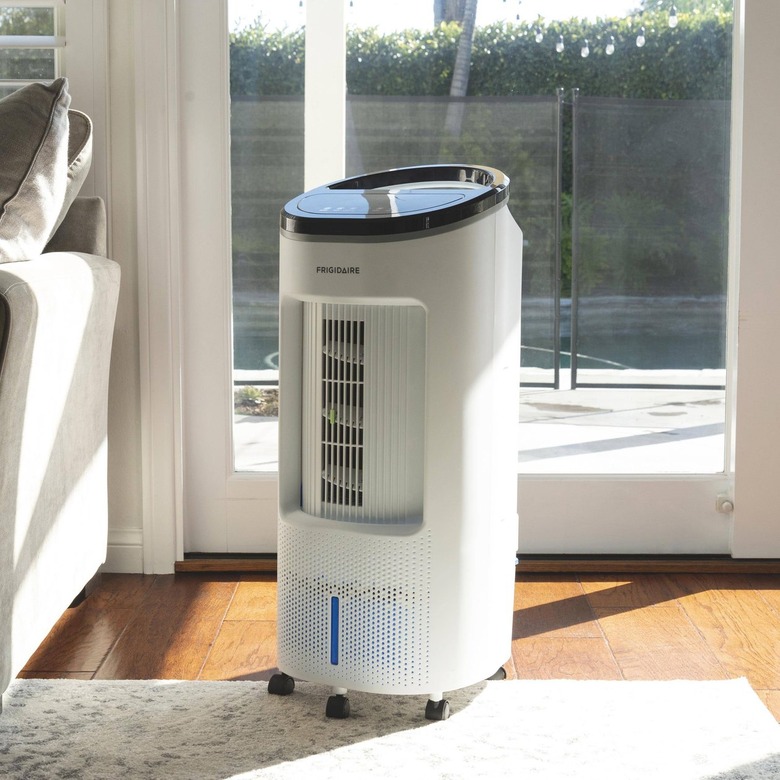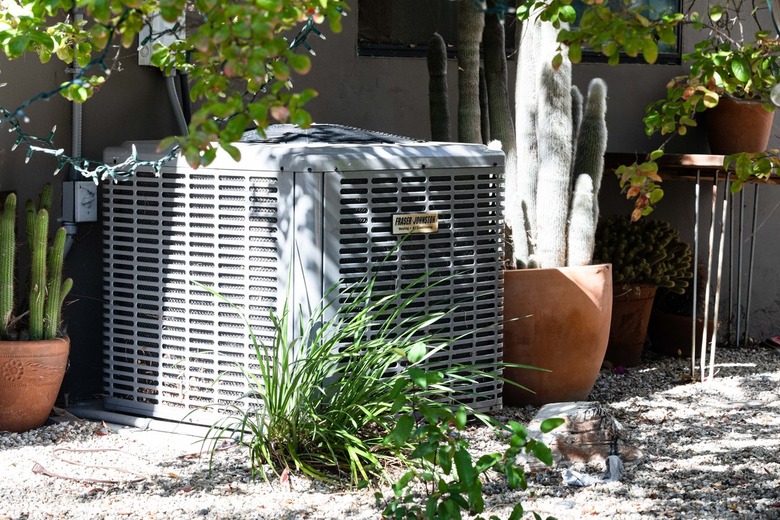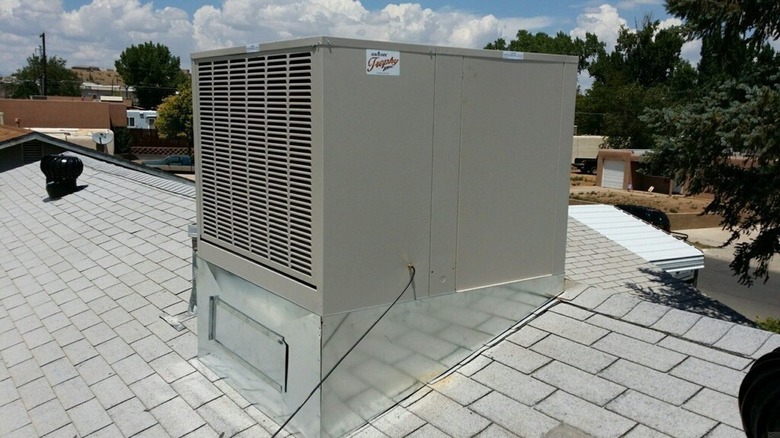What Is An Evaporative Cooler?
Like an air conditioning unit, an evaporative cooler relies on the physics of evaporation to provide cool air, and it can serve a single room, a section of a house, or a whole house. Evaporative coolers use much less energy than air conditioners, but they aren't capable of cooling to temperatures as low as those produced by air conditioners, and they do not dehumidify the indoor air.
Unlike traditional air conditioners, which contain a compressor and a closed system of tubing in which refrigerants cycle between the liquid and vapor states, an evaporative cooler is an open system that uses water, and some of the water that evaporates is circulated through the air. This additional water vapor raises the indoor humidity, which necessitates leaving windows open to create an airflow that allows the humid air to escape to the outdoors.
The propensity to raise humidity is the reason evaporative coolers are also known as swamp coolers, and the effect is the exact opposite in air conditioning systems, which dehumidify while they cool. Some contemporary evaporative coolers employ a two-stage cooling process that reduces humidity output, but on the whole, evaporative cooling isn't suitable for muggy, humid climates. In climates for which swamp coolers are suitable, however, they provide comfortable air for a fraction of the cost of running air conditioners, although they do require more frequent maintenance.
Tip
An evaporative cooler is a cooling device for the home that relies on water evaporation to produce cool air. It's cheaper to install and operate than an air conditioner, but because it blows humid air, it doesn't work in areas where the air is already humid.
How an Evaporative Cooler Works
Soak a towel, put it over a fan, and stand in front of it, and you'll get the basic idea of how an evaporative cooler works. Inside a swamp cooler housing are fibrous, absorbent evaporative pads (that's what the towel simulates), and they're kept wet by an internal water pump that circulates water from a pan at the bottom of the unit. A fan inside the housing blows air through the pads and sends the moist, cool air into the household duct system.
How does cooling happen? Anyone who paid attention during high school science class will have heard the terms "exothermic" and "endothermic" as applied to physical and chemical processes. Exothermic processes are those that release heat — a burning fire is a good example — while endothermic processes absorb heat. Evaporation is an endothermic process because the evaporating water molecules need energy to separate themselves from the liquid state, and they take this energy from the surrounding air. That's why evaporating water has a cooling effect.
Putting the "Swamp" in "Swamp Cooler"
Going back to the experiment with the towel and the fan, if you put a mirror in front of the towel several feet away, you'll notice that the mirror clouds up. That happens because the air coming from the towel is full of water vapor, and when you put a mirror in the cool airstream, the vapor condenses on it. Evaporative coolers expel water vapor in the same way, and a powerful unit can raise the relative humidity of the indoor air to as much as 70 percent.
This extra humidity isn't good for any house, but it's especially harmful if the air is already humid. This is the reason swamp coolers don't work well in areas where humidity is normally high, which in the United States is most places east of the Mississippi River, close to the Gulf of Mexico, or near the Pacific coastline. In these places, swamp coolers raise the humidity to uncomfortable levels, inhibiting the body's ability to cool itself by sweating and generally making the environment actually feel hotter.
In the arid climates of the Southwest deserts or the Rocky Mountains, on the other hand, the extra humidity is beneficial as long as it's accompanied by good air circulation to prevent the humid air from stagnating indoors. If they are willing to pay a little extra, homeowners in moderately humid climate zones can install two-stage evaporative coolers, which employ heat exchangers to cool the incoming air before it passes through the main cooling pads. These units raise relative humidity only to a range between 50 and 65 percent.
Types and Sizes of Evaporative Coolers
Like air conditioners, evaporative coolers are available in a variety of sizes, from units that can cool an entire house to those that are designed for a single room or for personal cooling.
- Down-discharge units: Whole-house evaporative coolers designed for rooftop installation typically exhaust cooled air through the bottom. A ductwork system distributes the cool air throughout the house.
- Side-discharge units: Like down-discharge units, side-discharge units are mounted outside but usually on the side of a building, or they are mounted on the roof with the outlet pointed into the attic.
- Window units: Like window air conditioners, window-mount swamp coolers are made to fit standard windows and are used primarily to cool single rooms.
- Portable units: Unlike fixed units, portable evaporative coolers can be moved anywhere cool air is needed. They typically don't have a dedicated water supply and need to be refilled manually.
Evaporative coolers are sized by the number of cubic feet per minute (cfm) of air they move. Whereas a portable unit may have a rating of around 300 cfm, a whole-house unit can have a rating of 7,000 cfm or more. To determine the size you need, you typically multiply the area of the space to be cooled by the height of the ceiling and divide by 2. For example, a 1,200-square-foot house with 8-foot ceilings would need a cooler with a minimum rating of 4,800 cfm.
Comparing Swamp Coolers and Air Conditioners
Both air conditioners and evaporative coolers are cooling systems that rely on evaporation, but because an air conditioner uses a sealed refrigeration system, it is able to remove moisture from the air rather than add moisture to it. As the evaporator coil in an air conditioner gets cold, moisture from the surrounding air condenses on the coil and drips into a drain pan, leaving dry air behind. Dehumidifiers work the same way; in fact, the person credited with the invention of the air conditioner, Willis Carrier, created air conditioning while trying to build a better dehumidifier for industrial use.
Despite the humidity problem they present, evaporative coolers have advantages over air conditioners that homeowners in suitable climates are bound to like:
- Evaporative coolers use about one-quarter of the energy that air conditioners use, and that's because they don't need the compressors found in traditional air conditioners. They only need energy to operate a blower fan and a water pump.
- Evaporative coolers are easier to install, costing about half as much as air conditioning systems.
- An evaporative cooler circulates fresh air, and because the windows should be open to create a draft, the indoor air quality tends to be better than with a closed-up house provided you perform the necessary cooler maintenance.
Some of the drawbacks of evaporative coolers include:
- An evaporative cooler needs more maintenance than an air conditioner. The cooling pads need to be cleaned or replaced on a monthly or bimonthly basis. Insufficient maintenance has a detrimental effect on air quality, and musty odors are common. If the unit is mounted on the roof, some ladder work is involved, which may be inconvenient or even impossible for some homeowners.
- Evaporative coolers can leak water, creating the possibility for roof leaks or damage to the roof or siding. The fact that they need a steady supply of water can be an issue in the arid regions for which they are most suitable.
- Installation of a rooftop or wall-mounted swamp cooler calls for cutting a fairly large hole that will be difficult to patch if the cooler is removed.
- Evaporative coolers don't cool as deeply as air conditioners and may not make a house comfortable on extremely hot days with temperatures in the high 90s and above.
Consider a Two-Stage Evaporative Cooler
No evaporative cooler will work well in the muggy Florida interior, which is perennially humid, but two-stage evaporative coolers may be effective cooling solutions for people in moderately humid climates in which a traditional swamp cooler wouldn't work. A two-stage cooler employs both direct and indirect methods to cool the air, and the process results in more efficient cooling. Two-stage cooling can result in indoor air temperature reductions of 10 to 13 degrees Fahrenheit even in areas of relatively high humidity, like Houston, where traditional evaporative cooling systems don't work.
In two-stage cooling, the incoming warm air passes through a heat exchanger that is cooled by water evaporation on the outer walls of the evaporator unit. The air doesn't come in contact with the water, so it doesn't pick up any moisture, and when the air is cooled down, it becomes less humid because it can hold less moisture. When the fan blows it through the main cooling pads, it picks up some humidity but not as much as it would if it were hot air coming directly from outside. This two-stage cooling process results in a 5 to 20 percent reduction in humidity (compared to standard evaporative cooling), and the indoor air is cooler as well as drier.
Evaporative Cooler Installation and Maintenance
A window-mounted evaporative cooler mounts just like an air conditioner, although the part of the unit that hangs outside is larger, and even though the unit is lighter overall, it may need to be supported by brackets. Whole-house units are typically installed with ductwork, which has to be larger in diameter and straighter than typical HVAC ductwork to ensure proper airflow, and it should be insulated to minimize heat exchange with the indoor air. Although a large house may have a ductwork system with several branch ducts, the most efficient distribution method is a straight duct that terminates with an air diffuser mounted in a central location in the building.
Routine swamp cooler maintenance, which should be performed monthly during the cooling season, includes removing the cooling pads and cleaning or replacing them. The drain pan also needs regular cleaning to kill mold that commonly grows there. Failure to perform these maintenance tasks impairs the ability of the air cooler to intake warm air to distribute cool air throughout the building, and it's also the number-one reason for the swampy, musty smells often associated with swamp coolers.
Because the air from an evaporative cooler is loaded with humidity, maintenance should also include regular cleaning of the duct outlets and registers. Any part of the ductwork that restricts airflow is a good place for mold to grow — which is why ductwork should be as straight as possible — so register grilles and walls opposite the registers need to be closely monitored and cleaned with soap and water or a 10 percent bleach solution at the first signs of discoloration. If you remember to keep some windows open while the cooler is operating to keep air circulating, it's less likely to stagnate indoors and create mold problems.


